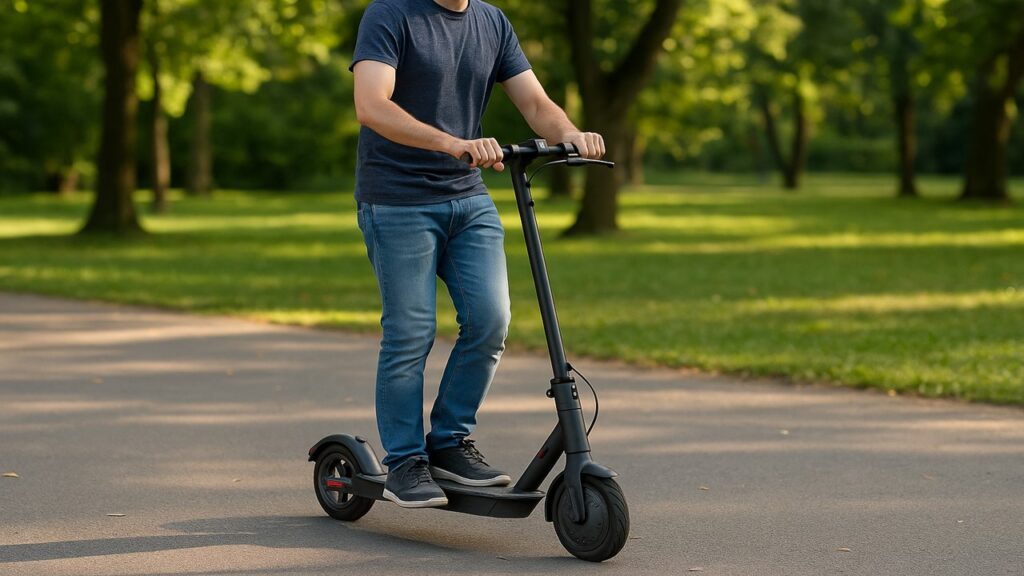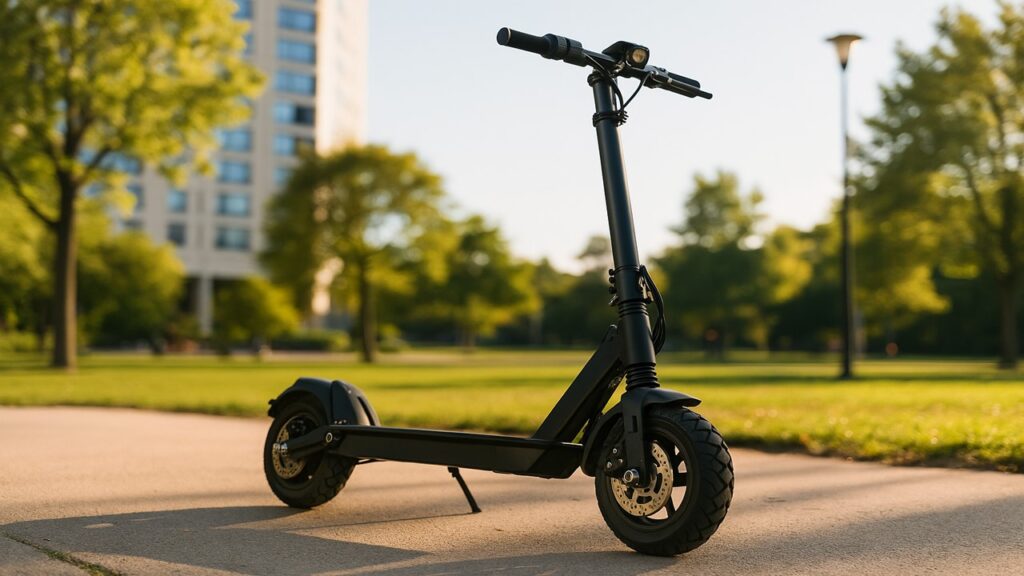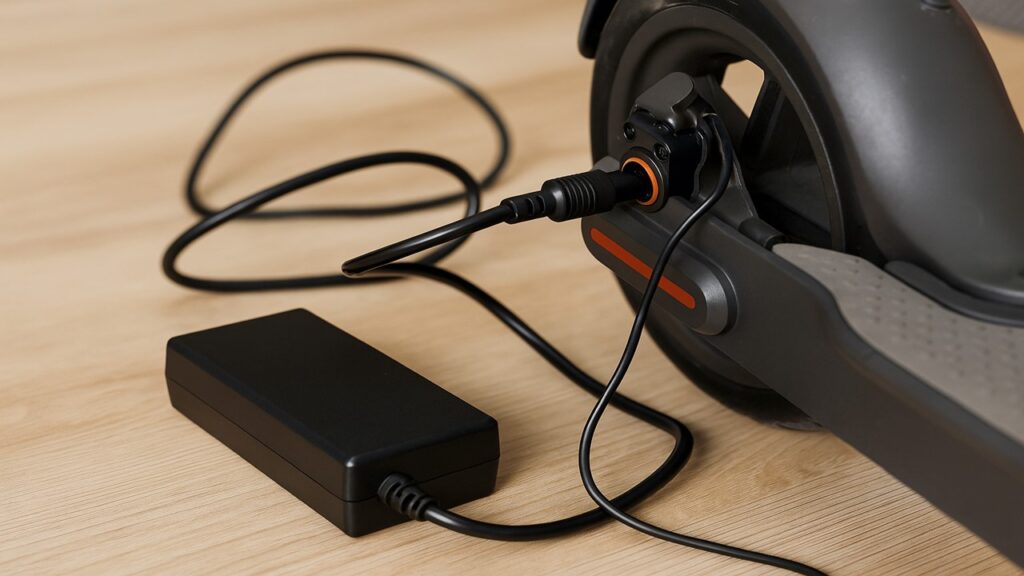
An electric scooter typically lasts between three and five years, depending on how it’s used and maintained. The real determining factors are the quality of its parts, how well the battery is cared for, and the kind of terrain it’s ridden on. With proper maintenance and mindful charging habits, a good scooter can easily last longer than the average lifespan most people expect.
Key Summary:
- Most electric scooters last between three and five years on average, though high-quality models can easily exceed five years with proper maintenance and smart charging habits.
- The battery, motor, and tires are the most influential parts of a scooter’s lifespan, with lithium-ion batteries typically lasting 300 to 500 charge cycles before performance drops.
- Riding conditions, storage environment, and maintenance routines play a major role in how quickly a scooter wears down or stays reliable over time.
- Regular care—like keeping tires inflated, charging the battery correctly, and storing the scooter indoors—can double its usable life and keep performance consistent year after year.
How Long Do Electric Scooters Really Last?
Most electric scooters are built to last around three to five years with regular use. Entry-level or budget models may start showing wear after one or two years, especially if used daily or stored improperly. Premium scooters from well-known brands tend to endure longer, often exceeding five years when properly maintained.
The difference largely comes down to build quality, battery management, and riding conditions. A scooter that’s used for short commutes on smooth roads and regularly serviced will last significantly longer than one ridden aggressively or in harsh weather. In short, the way you ride and care for your scooter can double—or halve—its expected lifespan.
Average Lifespan of Electric Scooters at a Glance
The average lifespan of an electric scooter depends on its category. Budget scooters, often built with cheaper components and smaller batteries, tend to last one to two years before performance declines. Midrange scooters, designed for daily commuting, typically hold up for about three to four years with moderate upkeep. Premium models, featuring robust frames, advanced battery systems, and sealed electronics, can last five years or more.
Regular maintenance, correct battery charging, and proper storage have a huge impact on how long a scooter remains reliable. Even a mid-tier scooter can rival a premium one if cared for consistently.
| Scooter Type | Average Lifespan | Key Features |
| Budget Models | 1–2 years | Basic components, limited waterproofing |
| Midrange Models | 3–4 years | Better battery systems, stronger build |
| Premium Models | 5–7+ years | Sealed electronics, reinforced frames, quality tires |
Main Factors That Affect an Electric Scooter’s Lifespan
How long your electric scooter lasts depends on a mix of design quality, riding habits, and upkeep. The following factors have the biggest impact:
- Build quality and frame materials
- Battery care and charging patterns
- Motor efficiency and cooling
- Terrain and riding frequency
- Regular maintenance and servicing
- Weather protection and storage
Each of these plays a distinct role in determining how long your scooter performs at its best. Let’s look at them more closely.
Build Quality & Materials
Scooters made from aircraft-grade aluminum or reinforced steel tend to resist fatigue, bending, and cracking far longer than cheaper alloy builds. Strong weld joints, reliable suspension, and durable folding mechanisms also contribute to long-term stability. Poor-quality materials, on the other hand, corrode quickly, loosen under vibration, and shorten the scooter’s usable life.
Battery Health & Charging Habits
The battery is the most vital component of an electric scooter and usually the first to decline. Lithium-ion batteries typically handle 300–500 charge cycles, equating to two to four years of regular use. Charging before it drops below 20 percent and unplugging before it reaches 100 percent can preserve capacity. Overcharging or leaving a battery drained for long periods leads to faster degradation.
Motor & Controller Performance
The motor and controller convert electrical power into motion and regulate speed. These parts wear out faster when overloaded, exposed to water, or pushed to high speeds frequently. Keeping the motor clean, ensuring proper ventilation, and avoiding sudden acceleration can prevent overheating and extend operational life.
Riding Conditions & Frequency
Scooters that are used daily or on uneven, steep, or wet terrain experience more mechanical stress. Dust and water intrusion can damage the bearings and wiring. Light commuting on smooth, dry surfaces helps maintain performance for years, while frequent off-road riding shortens lifespan considerably.
Maintenance Practices
Regular inspections—tightening bolts, lubricating moving parts, cleaning the deck, and checking brake wear—help catch small issues before they turn into expensive repairs. Neglecting these simple steps can lead to premature failure of key components like brakes and suspension.
Storage & Weather Resistance
Scooters stored indoors in mild, dry conditions last much longer than those left in rain, heat, or direct sunlight. Temperature extremes degrade the battery, while moisture can corrode wiring and connectors. Using a weatherproof cover and keeping the scooter charged during storage ensures consistent long-term performance.
Component-by-Component Lifespan Breakdown
Each part of an electric scooter wears at its own pace. Understanding how long specific components typically last helps you plan maintenance and avoid sudden breakdowns.
| Component | Average Lifespan | Common Issue | Maintenance Tip |
| Battery | 2–4 years | Reduced range over time | Charge between 20–90%, avoid full drains |
| Motor | 3–5 years | Overheating under heavy load | Avoid constant top-speed riding |
| Tires | 1–2 years | Punctures or wear | Maintain proper air pressure |
| Brakes | 1–3 years | Worn pads or rotors | Clean regularly, replace pads early |
| Controller | 2–3 years | Faulty signals or lag | Keep moisture out of the system |
| Wiring/Lights | 1–2 years | Loose connections or shorts | Inspect and secure cables monthly |
Routine care and timely replacements for high-wear parts—like tires and brake pads—make the biggest difference in how long your electric scooter stays road-ready.
How Long Does an Electric Scooter Battery Last?
The battery is the most critical part of an electric scooter and typically lasts between two and four years, depending on usage and care. Most lithium-ion batteries endure around 300 to 500 full charge cycles before noticeable capacity loss begins. Riders who commute short distances and charge responsibly can extend that life significantly.
Battery lifespan shortens when it’s frequently overcharged, stored in extreme heat, or left fully discharged for long periods. To maintain performance, it’s best to charge your scooter when it reaches around 20 percent and unplug it near 90 percent. Storing the scooter in a cool, dry place with the battery partially charged (around 60 percent) also helps preserve its health during long breaks.
Common Signs Your Scooter Is Nearing the End
Over time, every electric scooter starts showing signs of aging. Recognizing these early can save you from costly repairs or unexpected breakdowns on the road. Look out for declining range, unusual noises, or slower performance—these are often early indicators that parts are wearing out.
| Sign | Likely Cause | Suggested Action |
| Shorter travel range | Battery degradation | Replace the battery or check for charging issues |
| Reduced top speed | Motor wear or controller fault | Inspect and clean the motor; service the controller |
| Unusual noises or vibrations | Loose bolts or frame fatigue | Tighten joints, inspect frame for cracks |
| Weak braking | Worn pads or cables | Replace brake pads and adjust cables |
| Flickering lights | Wiring corrosion or loose connection | Clean contacts and secure wiring |
| Slower acceleration | Power output loss or battery issue | Diagnose battery and controller condition |
Regular check-ups and preventive maintenance can often restore some performance before full replacement becomes necessary.
How to Make Your Electric Scooter Last Longer
A few simple habits can dramatically increase the lifespan of your electric scooter. Even small adjustments to charging, storage, and riding behavior can add years of reliable use.
Here are practical ways to extend your scooter’s life:
- Charge smartly: Avoid full discharges and overcharging. Keep your charge cycles between 20 and 90 percent.
- Store it properly: Keep your scooter indoors, away from moisture, and avoid direct sunlight. Long-term storage should be in a dry, room-temperature environment.
- Ride smoothly: Sudden acceleration, harsh braking, and overloading strain the motor and frame. Ride at steady speeds whenever possible.
- Check tires regularly: Proper air pressure prevents uneven wear and protects the motor from extra load.
- Clean after rides: Dirt and water can damage bearings and wiring. Use a damp cloth rather than high-pressure water.
- Inspect monthly: Tighten bolts, check brake pads, and listen for odd noises. Small fixes now prevent major repairs later.
- Use genuine parts: Cheap replacements may save money upfront but often reduce performance and durability in the long run.
Consistency is key—routine maintenance always costs less than replacing an entire scooter.
Why Premium Electric Scooters Outlast Cheap Ones
Premium electric scooters often last two to three times longer than budget models because they’re built with higher-quality materials and better electrical components. The difference lies in design precision, engineering standards, and long-term reliability testing.
Here’s why high-end models deliver better longevity:
- Superior battery management systems: Premium scooters use advanced BMS technology that prevents overcharging and overheating, extending battery health.
- Stronger frame construction: Aluminum alloy or steel frames resist bending, cracking, and fatigue over time.
- Weather-sealed electronics: Proper insulation and IP-rated designs protect against moisture and dust, a common cause of controller failure.
- Enhanced braking and suspension: These components reduce stress on joints and tires, keeping the scooter stable for longer rides.
- Comprehensive warranties: Premium brands back their products with extended coverage, ensuring affordable replacements for key parts.
While cheap scooters may seem economical at first, the long-term repair costs and shorter lifespan often make premium models the better investment.
Warranty, Repairs, and Replacement Costs
A solid warranty can be a strong indicator of scooter quality and durability. Most reputable brands offer at least a one-year warranty covering the battery, motor, and controller. Premium manufacturers sometimes extend this to two years or more, showing confidence in their build quality. Always review what’s included, as some warranties cover labor while others only cover parts.
Replacement costs vary by component. A new battery typically costs between $150 and $400, while motors range from $100 to $250 depending on power output. Brake pads, tires, and lights are relatively inexpensive but require regular replacement. Factoring these costs into your purchase decision helps you understand the total cost of ownership—not just the upfront price.
Real-World Scooter Lifespan Examples
In real-world conditions, most commuters report getting about three years of steady performance from a midrange electric scooter before parts start to decline. For example, popular models like the Xiaomi M365 and Segway Ninebot Max often maintain good battery health past the 500-cycle mark with responsible charging. With regular servicing, these scooters can easily exceed 5,000 kilometers of use.
On the other hand, rental or shared scooters tend to wear out within a year due to constant use, weather exposure, and minimal maintenance. This comparison shows how ownership and care dramatically affect lifespan—private owners who maintain their scooters properly often double the longevity compared to shared fleets.
Final Thoughts
Most electric scooters last between three and five years, but care and usage make all the difference. Routine maintenance, smart charging habits, and gentle riding can stretch that lifespan well beyond the average. Investing in a quality model and following simple upkeep routines ensures you get the best return from your scooter—both in performance and longevity. With consistent care, even daily commuters can enjoy years of reliable, eco-friendly travel.
FAQs
How long do electric scooter batteries last?
Most batteries last between 2 and 4 years or about 300 to 500 charge cycles before losing significant capacity.
What wears out first on an electric scooter?
Tires, brake pads, and batteries are usually the first components to show signs of wear.
Can you replace an electric scooter battery?
Yes. Most scooters allow battery replacement, though premium models may require professional installation for safety.
Does riding in the rain damage a scooter?
Yes, unless your scooter has a proper IP rating. Water can corrode wiring and damage electronics over time.
Do solid tires last longer than air-filled ones?
Solid tires resist punctures and last longer but provide a rougher ride compared to pneumatic (air-filled) tires.

Max Volt is an electric scooter and e-bike enthusiast who rides daily and knows the nuts and bolts of every model. With years of hands-on repair experience and real-world testing, Max shares practical reviews, maintenance tips, and buyer guides to help riders choose the right gear with confidence. His mission is to make electric commuting safer, smarter, and more enjoyable for everyone.










